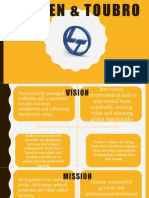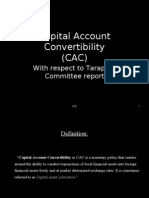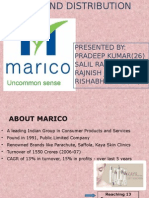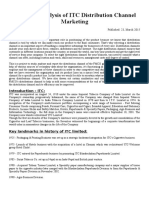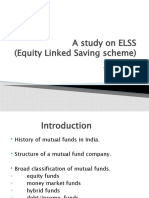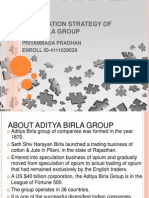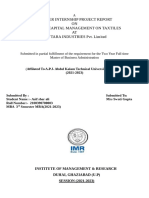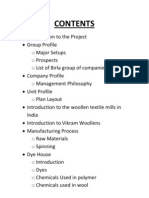Aditya Birla Summary
Aditya Birla Summary
Uploaded by
Chris NgoCopyright:
Available Formats
Aditya Birla Summary
Aditya Birla Summary
Uploaded by
Chris NgoCopyright
Available Formats
Share this document
Did you find this document useful?
Is this content inappropriate?
Copyright:
Available Formats
Aditya Birla Summary
Aditya Birla Summary
Uploaded by
Chris NgoCopyright:
Available Formats
DIVERSIFICATION STRATEGY OF ADITYA BIRLA GROUP
1. Company brief profile Birla group was started in 1857 as a cotton trading company at Pilani, Rajasthan. Today, the group is a US$29 billion corporation and is in the league of fortune 500 companies. It has 1.3 Lac employees belonging to 40 different nationalities. Over 60% of the groups revenues flow from overseas operations. It has presence in 26 countries. Sectors in: Non-ferrous metals, cement, textiles, chemicals, agri business, carbo black, mining, ferro chem, wind power, insulators, telecom, financial services, it-ites, retail, trading solutions. Group companies: Grasim Industries Ltd, Hindalco Industries Ltd, Aditya Birla Nuvo Ltd, UltraTech Cement Ltd.
2. Introduction Aditya Birla group of company was formed in the year 1870, when Seth Shiv Narayan Birla launched a trading business of cotton & Jute in Pilani, in the state of Rajasthan. His son, Baldeo Das Birla, had moved to Calcutta which was the hub of business activity and over there Baldeo Das Birlas son Ghanshyamdas Birla started up a jute mill. Thus in 1919 the family's industrial holdings were established. Then just after Indias independence, in the year 1947, Grasim weaving plant was started. Although Grasim was started as a textile manufacturing company it has diversified itself into various other industries like Viscose Staple Fiber (VSF), cement, chemicals and sponge iron. Now, Grasim Industries Ltd has become one of the Indian companies to make to the list of Forbes Asia's Fabulous 50 award winners. In 1958 rayon was added to the list of Grasim production list which had cotton and jute fiber. Rayon being a cellulose fiber has a high luster quality and was an emerging trend. It helped Grasim industries to increase its customer base as rayon fibers can be engineered to have a range of properties so that different demands of a wide variety of end customers can be met.
Fig 2: Aditya Birla group growth (1999-2005)
3. Diversification strategy of aditya birla group Up till now Birla group had diversified and expanded in the textile industry. This was the strategy of Growth diversification. In 1958, Birla group diversifierd to spread risk and thereby reduce it by establishing Hindalco - An aluminium facility at Renukoot in eastern Uttar Pradesh. To add value, acquisitions and mergers, with Indal, Birla Copper and the Nifty and Mt. Gordon copper mines in Australia, were done. This strengthened the position of Hindalco in Aluminium and Cooper industry. The aluminium operation extends from mining of bauxite to the production of not only primary aluminium but also the value added downstream products such as flat rolled products (FRP), extrusions and also customized consumer products such as foils. In 2007, Noveilis Inc. was acquired which made Hindalco fifth largest aluminium producer in the world. As stated by the management team, We leverage our strengths further when it comes to downstream strategy. The recent acquisition of downstream producer Novelis gives us a welldiversified geographical market base and enhances our stature in the area of downstream production. (Refer the fig 3a) Hindalco group has a consolidated turnover of USD 15.85 billion and hence has placed itself in the fortune 500 list.
To make its presence felt in international market, in 1969, Indo Thai Synthetics was formed in Thailand. Indo Thai supplies raw material to the world's leading fabric manufacturers. 70% of its product is exported to more than 30 countries including USA, Canada, Brazil, Argentina, Chile, Turkey, Greece, Belgium, France, Israel, Italy, Spain, Portugal, Germany, South Korea, Bangladesh, Hongkong and Taiwan. In 1978, Carbon black, used as a pigment and reinforcing phase in automobile tires, production was launched in Thailand. This helped Birla group to spread the risk further into diversified business. The diversification strategy of Birla group was not only vertical or horizontal but it also did a forward integration by forming Indo Gulf for the production of fertilizer, in 1988. The Sulphuric acid produced in the smelters of Hindalco group was used along with rock phosphate and ammonia to form Di-ammonium phosphate fertilizers as shown below (Refer fig 3b). These fertilizers are marketed under the known brand name Birla Balwan. Farmers prefer this brand in Di-ammonium phosphate fertilizers category.
Fig 3a: Diversification Synergies Due to the death of Aditya Birla in 1995, his son, Kumar Mangalam Birla, was made the Chairman of Birla group. Kumar Mangalam Birla did a restructuring and streamlining of the whole group. Then, Indian market was very attractive for cell phone industry; Kumar Mangalam Birla formed a joint venture with AT&T group to form idea cellular. Telecom services were recognized as an important tool for the socio-economic development of a country. Telecom
being the main supporting service for rapid growth and modernization of all the sectors of an economy, its growth in a developing country like India was obvious. Hence, Birla group made the right move of applying diversification strategy of growth and entered a very attractive market (Refer Exhibit 3b).
To continue diversifying into other emerging markets, in 1999, Birla group formed joint venture with Sun Life Financial Inc., one of the leading international financial services organizations from Canada, and formed Birla Sun Life Insurance Company Limited (BSLI). As insurance market in Indian had low entry barriers, the cost of entry was less and hence BSLI did not erode the bottom life of Birla group (Refer Exhibit 3c).
Fig 3b: Diversification - Forward Integration
Thus we can see that Birlas diversification strategies include Operational relatedness when they formed Grasim industry. Birla textile & Grasim could share resources like - plant, R&D facilities, distribution centers, etc. thereby saved cost. Diversification into metal business and formation of Hindalco was a good example of growth motive and risk spreading across businesses. Hindalcos diversification in the upstream and downstream was to have synergies due to operational relatedness. Diversification into cellular & insurance business gave Birla group entry into markets which were attractive and had low cost of entry. Thus, we can see
strategic relatedness in all the Birla groups business which has made a US $35 billion corporation and in the league of Fortune 500. (Refer: Exhibit 3d)
Exihibit 3a: Capacities of Grasim Group Capacity Viscose Staple Fibre (VSF) Joint venture :: Birla Jingwei Fibres Company Limited :: Rayon grade pulp :: Harihar, Karnataka :: AV Cell Inc :: AV Nackawic Inc. Cement (through its subsidiary UltraTech) :: Grey cement 51.9 million tpa (including 3.0 million tpa overseas capacity) 9.9 million cubic metres 560,000 tpa 258,000 tpa 70,000 tpa 122,500 tpa 189,000 tpa 70,000 tpa 333,975 tpa
:: Ready-mix concrete :: White cement Chemicals Textiles :: Yarn Grasim Bhiwani Textiles Ltd. (Subsidiary) :: Fabric :: Yarn
8832 spindles
146 looms 35,808 spindles
Exhibit 3b: Growth of Idea Cellular
Exhibit 3c: Aditya Birla Group
Globally, the Aditya Birla Group is: :: A metals powerhouse, among the worlds most cost-efficient aluminium and copper producers. Hindalco-Novelis is the largest aluminium rolling company. It is one of the three biggest producers of primary aluminium in Asia, with the largest single location copper smelter. :: No.1 in viscose staple fibre :: The largest producer of carbon black :: The fourth-largest producer of insulators :: The fifth-largest producer of acrylic fibre :: Among the top 10 cement producers
:: Among the best energy-efficient fertiliser plants
In India, the Aditya Birla Group is:: :: A top fashion (branded apparel) and lifestyle player :: The second-largest producer of viscose filament yarn :: The largest producer in the chlor-alkali sector :: Among the top three mobile telephony companies :: A leading player in life insurance and asset management :: Among the top two supermarket chains in the retail business :: Among the top 10 BPO companies
Exhibit 3d: Diversified Aditya Birla Group
References: Aditya Birla Overview, 2012, Cement major and global leader in Viscose Staple Fibre, Aditya Birla Management Corp. Pvt. Ltd, viewed 03 July 2012, <http://www.grasim.com/about_us/index.htm>
Aditya Birla Hindalco, 2012, About us, Aditya Birla Management Corp. Pvt. Ltd, viewed 03 July 2012, < http://www.hindalco.com/about_us/overview.htm>
The Origin Of, 2007, Birla Group, TheOriginOf .com, viewed 03 July 2012, <http://www.theoriginof.com/birla-group.html>
Aditya Birla Hindalco, 2012, Strategy, Aditya Birla Management Corp. Pvt. Ltd, viewed 03 July 2012, <http://www.hindalco.com/strategy/strategy.htm>
Indo-Thai Synthetics, 2007, Company Profile, Indo-Thai Synthetics Co., Ltd, viewed 03 July 2012, <http://www.indo-thai.com/aboutus/cmppro.html>
Birla Carbon, 2011, About us, Birlacarbon.com, viewed 03 July 2012, <http://www.birlacarbon.com/about_us/carbon_black_business.htm>
Idea Cellular Ltd., 2012, Home, ideacellular.com, viewed 03 July 2012, <http://www.ideacellular.com/wps/portal>
Shrutika Verma, 2011, An Idea Can Bring Growth, businessworld.in, viewed 03 July 2012, <http://www.businessworld.in/businessworld/content/Idea-Can-Bring-Growth.html>
Bimtech, 2006, Birla family, bimtech.wordpress.com,viewed 03 July 2012, <http://bimtech.wordpress.com/founders/birla-family/>
Aditya Birla Hindalco, 2012, Aditya Birla Group profile, Aditya Birla Management Corp. Pvt. Ltd, viewed 03 July 2012, <http://www.adityabirla.com/the_group/index.htm>
You might also like
- CIO100 - 2021 - Winners - DetailsDocument48 pagesCIO100 - 2021 - Winners - Detailsbavitha.nair100% (2)
- Kalyan Jewellers HSBC 3oct2022Document33 pagesKalyan Jewellers HSBC 3oct2022Ankk Tenderz100% (1)
- Bombay DyeingDocument15 pagesBombay DyeingAnurag SarafNo ratings yet
- Leadrship Through Differentiation Hero MotorsDocument11 pagesLeadrship Through Differentiation Hero MotorsSushma MishraNo ratings yet
- ABFRLDocument11 pagesABFRLGourab RayNo ratings yet
- The Textile MagazineDocument110 pagesThe Textile MagazineKayPeaB100% (2)
- Mahatma Gandhi University, Kottayam, Kerala.: Mr. Ahammed Jimshad KDocument83 pagesMahatma Gandhi University, Kottayam, Kerala.: Mr. Ahammed Jimshad KAvinash ThakurNo ratings yet
- Brand CloutDocument10 pagesBrand CloutpuneetdubeyNo ratings yet
- A Report On Turnaround Strategy of Tata MotorsDocument16 pagesA Report On Turnaround Strategy of Tata MotorsShazia BakaliNo ratings yet
- Ongc Growth StrategyDocument10 pagesOngc Growth StrategydhavalmevadaNo ratings yet
- Larsen & ToubroDocument17 pagesLarsen & ToubroDiksha NatarajanNo ratings yet
- Eic-Itc Kirti SabranDocument14 pagesEic-Itc Kirti Sabrankirti sabranNo ratings yet
- 1.4.classification & Characteristics of Rural ConsumerDocument5 pages1.4.classification & Characteristics of Rural ConsumerkhushiYNo ratings yet
- Aditya Birla Group Global StrategyDocument4 pagesAditya Birla Group Global StrategyUdit100% (1)
- Hero Honda Motors (India) LTD.: Is It Honda That Made It A Hero?Document17 pagesHero Honda Motors (India) LTD.: Is It Honda That Made It A Hero?JatinMahaJanNo ratings yet
- 1 Vi JohnDocument2 pages1 Vi JohnAnish Kamat100% (1)
- Capital Account ConvertibilityDocument15 pagesCapital Account Convertibilityanirbank4b100% (3)
- Voltas - IndiaDocument30 pagesVoltas - IndiaShyam RajNo ratings yet
- Asian Paints Limited: Painting History: March 2019Document26 pagesAsian Paints Limited: Painting History: March 2019Swarup Singh Deo0% (1)
- Case - Retaining Profits at Apna BazaarDocument3 pagesCase - Retaining Profits at Apna BazaarSaransh ThahraniNo ratings yet
- Final Grp1 Bay MadisonDocument11 pagesFinal Grp1 Bay MadisonDilip Thatti0% (1)
- Organization Study: Mangalore Chemicals and Fertilizers LTDDocument14 pagesOrganization Study: Mangalore Chemicals and Fertilizers LTDHariprasad bhat0% (1)
- MM Project FinalDocument64 pagesMM Project FinalAnkita KothariNo ratings yet
- Infosys HRM PresentationDocument34 pagesInfosys HRM PresentationShubhneet KaurNo ratings yet
- On Nirma CaseDocument36 pagesOn Nirma CaseMuskaan ChaudharyNo ratings yet
- Leo Burnett IndiaDocument17 pagesLeo Burnett IndiaAdnan patelNo ratings yet
- SM AssignesDocument8 pagesSM AssignesYugandhar MakarlaNo ratings yet
- MaricoDocument6 pagesMaricopradeepsiib100% (2)
- STP Analysis of DaburDocument11 pagesSTP Analysis of Daburamit khillareNo ratings yet
- Leadership Style of Udaan: Group 5 (A)Document11 pagesLeadership Style of Udaan: Group 5 (A)Aditya Raj100% (1)
- Submitted By:-Nishant Anand 2K19G019 TERM-5 Submitted To: - Dr. Moid Uddin AhmadDocument7 pagesSubmitted By:-Nishant Anand 2K19G019 TERM-5 Submitted To: - Dr. Moid Uddin AhmadNishant Anand100% (1)
- 997 Aadya Tyagi CRM 1 7664 996539954Document6 pages997 Aadya Tyagi CRM 1 7664 996539954Vaibhav SinghNo ratings yet
- Times GroupDocument7 pagesTimes GroupRakesh SukumarNo ratings yet
- Indian Suv Scorpio' Takes On Global Players in Us Market: Presented To - Dr. Gautam DuttaDocument14 pagesIndian Suv Scorpio' Takes On Global Players in Us Market: Presented To - Dr. Gautam DuttaAmrit PatnaikNo ratings yet
- M1906 Heet General Management Project ReportDocument65 pagesM1906 Heet General Management Project ReportSatish WagholeNo ratings yet
- Why Brands FailDocument28 pagesWhy Brands Failkrkreddy99No ratings yet
- Uniliver Strategic Management AnalysisDocument38 pagesUniliver Strategic Management AnalysisIsfandyar KzNo ratings yet
- A Critical Analysis of ITC Distribution Channel MarketingDocument9 pagesA Critical Analysis of ITC Distribution Channel MarketingNishkarshNo ratings yet
- Unit 7Document27 pagesUnit 7Pawan SinghNo ratings yet
- Vivel - Brand EquityDocument13 pagesVivel - Brand EquityShivkarVishalNo ratings yet
- Q4. Apple SG5Document2 pagesQ4. Apple SG5Fadhila Nurfida HanifNo ratings yet
- A PPT On ELSSDocument21 pagesA PPT On ELSSVinay BhargavaNo ratings yet
- of Surf ExcelDocument22 pagesof Surf Exceljanu882000100% (2)
- ITC LTD Format 15Document104 pagesITC LTD Format 15Aishwary SharmaNo ratings yet
- Be - Term 2 B 36 2019Document6 pagesBe - Term 2 B 36 2019santosh vighneshwar hegdeNo ratings yet
- HDFC FinalDocument19 pagesHDFC FinalLavina JainNo ratings yet
- Corporate Strategy Assignment 2Document10 pagesCorporate Strategy Assignment 2SRINo ratings yet
- Apple Food Products - B2Document9 pagesApple Food Products - B2Badass WomanNo ratings yet
- Game Theory of E Commerce CompaniesDocument13 pagesGame Theory of E Commerce CompaniesAsif ShaikhNo ratings yet
- SDM Project FinalDocument9 pagesSDM Project Finalanon_700727161No ratings yet
- Pankhuri - Aditya BirlaDocument7 pagesPankhuri - Aditya BirlaAnkush JainNo ratings yet
- Britannia Vs Mcvities: Presented by Group 4Document64 pagesBritannia Vs Mcvities: Presented by Group 4Pragya AgrawalNo ratings yet
- SEWA Trade Facilitation Centre A - FeedbackDocument31 pagesSEWA Trade Facilitation Centre A - Feedbackliferocks232No ratings yet
- 057 Assignment 2Document8 pages057 Assignment 2Gulzar AhmedNo ratings yet
- Case Study 4 Ito-YokadoDocument3 pagesCase Study 4 Ito-YokadoHyChoNo ratings yet
- DSCM Cia 1Document62 pagesDSCM Cia 1Albert Davis 2027916No ratings yet
- Group 5 BPCLDocument31 pagesGroup 5 BPCLAnirudh Gupta100% (1)
- Prudential Fruits Processing CompanyDocument6 pagesPrudential Fruits Processing Companyhope 23No ratings yet
- Diversification Strategy of Aditya Birla Group: Baldeo Das Birla, BaldeoDocument6 pagesDiversification Strategy of Aditya Birla Group: Baldeo Das Birla, BaldeovaidehiNo ratings yet
- Diversification StrategyDocument10 pagesDiversification StrategyAnil Kumar Sankuru0% (1)
- List of Projects CompletedDocument15 pagesList of Projects CompletedRohit SharmaNo ratings yet
- Amit Jha SIP Kara WipesDocument66 pagesAmit Jha SIP Kara WipesNishant JhaNo ratings yet
- Birla Afrid EditedDocument25 pagesBirla Afrid EditedMohammed AfridNo ratings yet
- Kumar Mangalam Birla: How He Proved His Critics WrongDocument24 pagesKumar Mangalam Birla: How He Proved His Critics WrongShriram DeshpandeNo ratings yet
- Ilovepdf MergedDocument49 pagesIlovepdf MergeddighasonepurNo ratings yet
- Rajashree Cement: Engine On Load: Ahmedabad IIMA/PROD0264Document33 pagesRajashree Cement: Engine On Load: Ahmedabad IIMA/PROD0264Amritesh Kumar SinghNo ratings yet
- A Summer Training Project ReportDocument65 pagesA Summer Training Project Reportnaqeebluv75% (4)
- Financial Assignment-I WaccDocument2 pagesFinancial Assignment-I WaccAshwath PutturNo ratings yet
- GrasimDocument18 pagesGrasimmonish147852No ratings yet
- Sample Synopsis3Document10 pagesSample Synopsis3sam bhujadeNo ratings yet
- Project ReportDocument48 pagesProject ReportMalharNo ratings yet
- Deming Prize BrochureDocument9 pagesDeming Prize BrochureAbhinandan RathNo ratings yet
- Indian Cement IndustryDocument27 pagesIndian Cement IndustrySubhamay Biswas100% (1)
- New Mba 2 Year ProjectDocument79 pagesNew Mba 2 Year Projectasif sher aliNo ratings yet
- Summer Training Project Report On "Comparative Study of J.K. Cements Financial Trends and With Other Companies"Document52 pagesSummer Training Project Report On "Comparative Study of J.K. Cements Financial Trends and With Other Companies"Mohd ShahidNo ratings yet
- Prahlad 123 PDFDocument24 pagesPrahlad 123 PDFPrahlad Singh Bundela100% (1)
- List of Award Winners OF Rajiv Gandhi National Quality AwardsDocument19 pagesList of Award Winners OF Rajiv Gandhi National Quality AwardsAjay KaushikNo ratings yet
- Station PreferenceDocument6 pagesStation PreferenceSAMARTH patilNo ratings yet
- "Taking India To The World"Document41 pages"Taking India To The World"shreevarNo ratings yet
- Grasim-Annual-Report-2020-21 - 20211001Document502 pagesGrasim-Annual-Report-2020-21 - 20211001SandyNo ratings yet
- PDS-twist FC-73EDocument1 pagePDS-twist FC-73ESetu ShroffNo ratings yet
- Training PartDocument8 pagesTraining PartMayank BhardwajNo ratings yet
- Birla Cement & Aditya Birla Training & DevelopmentDocument109 pagesBirla Cement & Aditya Birla Training & Developmentrahulsogani123No ratings yet
- Chapter - 2 Company ProfileDocument17 pagesChapter - 2 Company ProfileSarva ShivaNo ratings yet
- Madura Fashion & LifestyleDocument6 pagesMadura Fashion & LifestyleKunal SalunkeNo ratings yet
- MMA CaseDocument11 pagesMMA CaseHemant bhanawatNo ratings yet
- Shri Vaishnav Institute of Technology & Science IndoreDocument26 pagesShri Vaishnav Institute of Technology & Science IndoreDinesh PatelNo ratings yet
- Project OrganizationalDocument95 pagesProject Organizationallink7096907539No ratings yet










